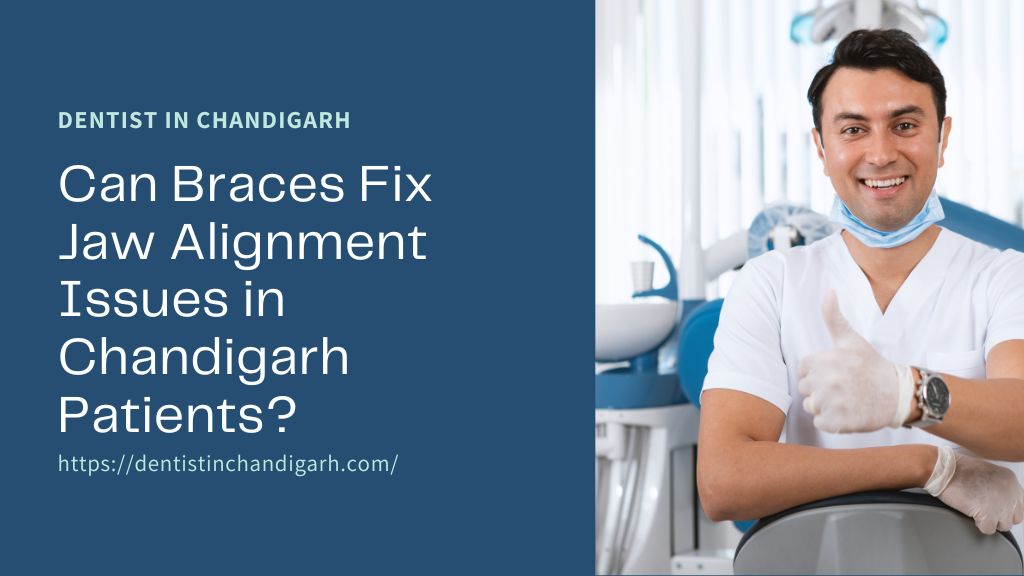Have you ever noticed that someone’s smile looks slightly uneven, or that they struggle to chew comfortably? This might be due to jaw alignment issues.
When the upper and lower jaws don’t line up properly, it can affect more than just the way someone looks.
It can impact chewing, speaking, and even lead to long-term jaw pain or wear on the teeth.
For many people in Chandigarh, jaw misalignment is a concern that begins in childhood and may continue into adulthood if left untreated. Thankfully, orthodontic treatments like Braces can offer a solution.
In this article, we’ll explore how jaw alignment problems occur, what signs to watch out for, and how Braces can play a major role in correcting the issue.
What Is Jaw Misalignment?
Understanding the Jaw’s Role
The jaw isn’t just there to help us chew. It also plays a role in speaking clearly, keeping facial balance, and expressing emotions through our smile. When the jaw isn’t aligned properly, it can throw off these everyday actions.
You might notice uneven wear on your teeth, frequent jaw pain, or even difficulty closing your mouth comfortably.
Jaw misalignment can also make certain sounds harder to pronounce and may cause discomfort when eating hard or chewy foods.
Over time, these issues can become more noticeable and uncomfortable if not addressed.
That’s why visiting the Best Dentist in Chandigarh can make a real difference—early diagnosis and targeted orthodontic care can help restore comfort, function, and balance to your smile.
Types of Jaw Misalignment
There are several common types of misalignment. An overbite happens when the upper teeth extend far over the lower ones. An underbite is when the lower teeth stick out more than the upper ones.
A crossbite occurs when some upper teeth sit inside the lower teeth when the mouth is closed.
And an open bite means that the front teeth don’t touch at all when the back teeth are closed.
Each of these alignment problems affects jaw movement and bite differently. They can also cause long-term issues like speech problems, difficulty brushing properly, and increased risk of tooth damage.
What Causes Jaw Alignment Problems?
Common Causes
Jaw alignment issues can be caused by a range of factors. In many cases, it’s genetic. If parents had jaw alignment problems, it’s likely their children will too.
Certain childhood habits, like thumb sucking or using a pacifier for too long, can also influence how the jaws grow.
Accidents or facial injuries during early development can change the natural position of the jaw, leading to long-term bite issues.
Even poor dental habits or early tooth loss can cause the remaining teeth to shift in ways that affect jaw alignment.
When to Spot It
Jaw issues often show early signs. A clicking or popping sound in the jaw, especially while chewing, could indicate misalignment.
If the bite feels uneven or the jaw locks up sometimes, these are warning signs.
Some people might also notice discomfort while chewing or find that their teeth don’t close properly when the mouth is shut.
Spotting these signs early is important, especially for kids and teens. Early intervention usually means easier, faster treatment.
How Do Braces Work on Jaw Alignment?
Braces and Bone Movement
Braces aren’t just for straightening teeth—they also help guide the movement of the jaw. By applying steady, gentle pressure over time, they shift the teeth into better positions.
Since the teeth and jawbones are connected, moving the teeth also affects the way the jaw aligns.
In many cases, this slow pressure helps the jaw settle into a more natural position. The result is not only a straighter smile, but also a balanced bite and improved jaw function.
Braces vs Other Treatments
In some cases, additional tools are used along with Braces, like rubber bands (elastics), palate expanders, or headgear. These tools help adjust how the upper and lower jaws relate to each other.
Severe alignment problems may require surgery to reposition the jaw bones. But many moderate cases can be corrected using orthodontic treatment alone, avoiding the need for surgical procedures.
Who Needs Braces for Jaw Alignment in Chandigarh?
Children and Teens
Jaw alignment issues are easier to treat while a child is still growing. Since their bones are more flexible, Braces can guide their jaw into proper alignment with less resistance.
Early treatment can also prevent more serious problems later in life, including speech difficulties, tooth wear, or facial imbalance.
Dentists often recommend early orthodontic evaluations for children around age 7 to catch potential issues as early as possible.
Adults
Adults can also benefit from treatment, even if it takes longer. Jawbones are more set in place, but Braces can still improve alignment by shifting teeth and making the bite more functional.
Adults with jaw pain, uneven bite, or headaches caused by misalignment often find relief after treatment.

Local Insight: Why Chandigarh Residents Choose Orthodontic Help
People in Chandigarh are increasingly aware of the importance of dental health. With access to skilled orthodontists and modern dental technology, more families are seeking early consultations.
Whether it’s for children needing early intervention or adults finally addressing long-term discomfort, the city offers excellent resources for jaw alignment care.
What Happens During Braces Treatment for Jaw Issues?
Step-by-Step Journey
The journey begins with a full dental check-up. X-rays, scans, or impressions are taken to understand the jaw and bite. A personalised treatment plan is then created to shift the teeth and align the jaws.
Next comes the placement of Braces. These are attached to the teeth and connected with wires that gently move them. Some patients may also be given elastics or other appliances to assist with jaw positioning.
Throughout treatment, regular check-ups allow the orthodontist to adjust the braces and monitor progress.
How Long Does It Take?
Treatment time depends on the severity of the misalignment. Minor issues may take around 12 to 18 months. More complex problems could require up to 36 months.
Following instructions—like wearing elastics and attending appointments—can help speed up results and make treatment more effective.
Results You Can Expect
Health Benefits
When the jaw is aligned properly, chewing becomes easier and more comfortable. It also improves speech in some cases and reduces pressure on the jaw joint.
Which can prevent pain or long-term issues like TMJ disorders. An aligned bite also helps prevent uneven tooth wear and gum problems in the future.
Aesthetic Improvements
Beyond function, jaw alignment often changes how the lower face looks. A balanced jawline, straighter teeth, and improved bite can boost self-esteem.
For teens especially, the change can bring a noticeable difference in confidence and comfort when smiling or speaking.
Real-Life Example: Jaw Correction with Braces
Meet Amandeep from Chandigarh
Amandeep, a 17-year-old student from Chandigarh, had a noticeable underbite. This made it hard for him to chew properly and often caused jaw discomfort.
He was referred to an orthodontist who placed braces and used rubber bands to help adjust his jaw.
Over the course of 24 months, Amandeep followed the treatment plan closely. By the end, his underbite was corrected, his chewing improved, and he no longer experienced jaw pain. He also felt more confident smiling in photos and talking in school presentations.
Are There Risks or Discomforts?
Common Concerns
Like most dental treatments, Braces come with some discomfort. During the first few days after placement and after adjustments, patients may feel soreness in their teeth or jaws. There may also be irritation inside the cheeks from brackets.
How to Manage Them
These discomforts usually go away within a few days. Over-the-counter pain relief can help manage the soreness.
Eating soft foods and rinsing with warm salt water are also useful. Keeping the braces clean with proper brushing and flossing is important to avoid plaque buildup and gum problems.
Post-Braces Care for Jaw Alignment
Retainers Matter
Once the braces come off, treatment isn’t over. A retainer is usually given to keep the teeth and jaw in their new position.
Without it, teeth may shift back over time. Retainers are often worn full-time for the first few months, and then only at night.
Long-Term Monitoring
Even years after treatment, it’s helpful to have regular dental check-ups. If any jaw discomfort or changes in bite appear again, they can be caught and corrected early.
Staying alert and keeping up with retainers can protect the long-term success of the treatment.
Alternatives If Braces Aren’t Enough
Surgical Options
In cases where the jaw bones are severely misaligned and braces alone can’t help, corrective jaw surgery may be suggested.
This surgery reshapes the upper or lower jaw to improve how they fit together. It’s often followed by braces to fine-tune the bite.
Other Appliances
Some mild cases may benefit from palate expanders, removable clear aligners, or nighttime appliances.
Each option depends on the specific jaw problem and patient’s age. An orthodontist will recommend the best approach based on a full evaluation.
Concluion
Jaw alignment problems can affect more than your smile—they can cause jaw pain, make chewing difficult, and impact speech.
Thankfully, with modern orthodontics, these issues are treatable. Many patients in Chandigarh are now experiencing lasting relief with early diagnosis and targeted care.
Using braces, orthodontists can guide both teeth and jaw into better alignment, improving comfort, function, and overall oral health. If you’re noticing bite issues or jaw discomfort, it’s a smart time to seek help.
At Dentist in Chandigarh, we offer expert care for jaw alignment. Book a consultation today and take the first step toward a healthier smile.


